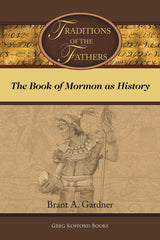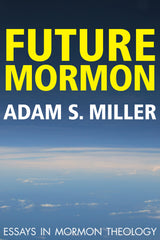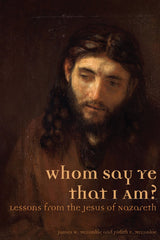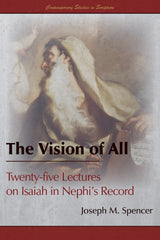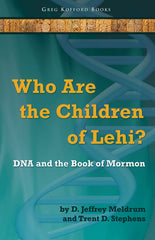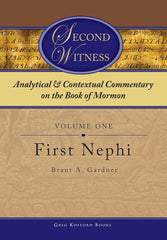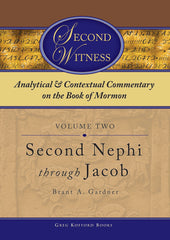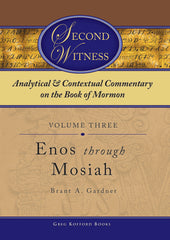News
New Year's Ebook Flash Sale December 29 2020

As we welcome 2021, we are pleased to offer discounted prices on select ebooks on scripture, doctrine, and community. This sale runs from January 1–4 and is available for both Kindle and Apple ebooks.
Sale ends Monday, Jan 4.
Doctrine| Scripture | ||
|
$17.99 |
$27.99 |
$22.99 |
|
$18.99 |
$22.99 |
$23.99 |
| Doctrine | ||
|
$30.99 |
$17.99 |
$9.99 |
|
$26.99 |
$16.99 |
$18.99 |
| Community | ||
|
$18.99 |
$14.99 |
$18.99 |
|
$23.99 |
$18.99 |
$9.99 |
Spring Flash Sale: Up to 88% off Select Ebooks March 24 2020
Stay at home with a great book and help take the pressure off delivery services by going paperless. From now through Easter, download select ebook titles for 30% to 88% off regular price.
Sale ends Monday, 4/12/2020
****NOTE: Due to an error, the discounts for the Kindle ebooks of Second Witness volumes 5 and 6 were not applied. They should be available at the discounted rate by Sunday*****
Insightful messages on justice, mercy, hope, community, and inspiring outlooks on the future during these difficult times. Discounted right now to just $1.99 (up to 88% off regular retail price).
|
$9.95 |
$16.99 |
$16.99 |
The message of Jesus is one of hope and healing. Spend time contemplating the life and mission of the Savior with thought-provoking and inspiring scholarship. Discounted right now to 50% off regular retail price.
|
$23.99 |
$9.99 |

$22.99 |
The Book of Mormon proclaims another witness of the mission of Jesus Christ. Deepen your knowledge and understanding of this sacred book with studies that explore its text, history, and origins. Discounted right now to 30% off regular retail price.
|
$25.99 |
$17.99 |
$20.99 |
|
$22.99 |
$17.99 |
$27.99 |
|
$27.99 |
$22.99 |
$9.99 |
|
$29.99 |
$29.99 |
$29.99 |
|
$29.99 |
$29.99 |
|
Free ebook offer: The End of the World, Plan B: A Guide for the Future November 08 2018
FREE EBOOK FOR NEWSLETTER SUBSCRIBERS
Book description:
Environmental decline, political gridlock, war and rumors of war, decadence, and immorality. The End of the World, Plan B traces the idea of the end, or destruction, of the world through a number of spiritual traditions. It shows that our present understanding of the “end game” has been distorted by a modern emphasis and demand on justice as the ultimate good. As an alternative to this self-destructive approach, Charles Shirō Inouye shows that in these traditions, justice is not the isolated end in itself that we ought strive for; rather it is taught in tandem with its balancing companion: compassion. Plan B is a hopeful alternative to our fears about how things are going.
“Inouye reminds us that justice is not enough and that obedience is not the currency of salvation. He urges us to recognize the limits of the law, to see that, severed from a willingness to compassionately suffer with the world’s imperfection and evanescence, our righteous hunger for balancing life's books will destroy us all.” — Adam S. Miller
DID YOU KNOW? Amazon pays authors and publishers roughly half the royalty percentage on ebooks compared to other services such as Apple, Barnes & Noble, and Kobo. Please consider increasing your support for independent authors and independent publishing by switching from Kindle to Apple Books (iBooks), Nook, or Kobo. Thank you!
STEPS TO DOWNLOAD
**Ebook file must be downloaded onto a laptop or desktop computer. After downloading, you can transfer the file to your ebook reader, tablet, or smartphone app.**
1. Enter your email address in the form below to sign up for our newsletter and receive a welcome email with instructions (check your junk mail if you do not see it). If you are already a newsletter subscriber, you should have received an email with this free ebook offer and instructions to download.
2. Click the here to open the ebook page on our website. Select which ebook format you wish to download (Kindle, Apple, Nook/Kobo). The price will show as $13.95 but will change to $0.00 as you complete these steps.
3. Click Add to Cart.
4. Click Checkout.
5. On the Customer Information page, fill out your name and address information. Enter the discount code that you received. The discount code will reduce the price of the book to $0.00.
6. Click Continue to Payment Method. You will not be required to enter payment info. DO NOT ENTER ANY CREDIT CARD INFORMATION.
7. Click Complete Order. You will be emailed a link to download the ebook along with instructions for transferring the ebook file to an e-reader device or tablet/smartphone app (check your junk mail if you do not see it).
Note: Once you have downloaded your ebook, it will be on your computer's hard drive, most likely in the "Downloads" folder. Kindle format will end with ".mobi." All other formats will end with ".epub."
Flash Sale: 40%-63% off Mormon theology titles! October 25 2018
Friday, Oct 26 through Monday, Oct 29. Theology titles by James McLachlan, Blake Ostler, Adam Miller, Joseph Spencer, James Faulconer, Jacob Baker, Blair Van Dyke, Loyd Ericson, Charles Inouye, Charles Harrell, Robert Millet, and more...Book of Mormon Flash Sale: 40%-64% off! September 20 2018
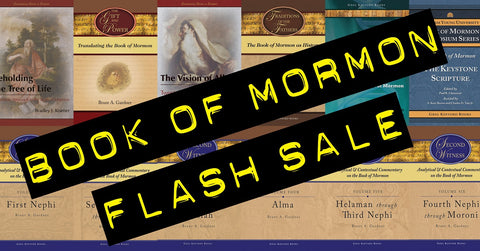
Friday, Sep 21 through Monday, Sep 24
In commemoration of Joseph Smith receiving the golden plates on September 22, 1827, we are pleased to offer a sale on the following Book of Mormon titles:*
Ebooks
|
$20.99 |
$27.99 |
$22.99 |
|
$27.99 |
$9.99 |
Print Books
|
$39.95 |
$39.95 |
$39.95 |
|
$49.95 |
$39.95 |
$39.95 |
|
$34.95 |
|
$129.95 |
*Offer valid for US domestic customers only. Print book sale limited to available supply.
Q&A with Laura Rutter Strickling for On Fire in Baltimore: Black Mormon Women and Conversion in a Raging City September 11 2018

Q: Will you give us a little background into your formal education and how it relates to this book.
A: I received an undergraduate degree from Brigham Young University way back in 1977, then, twenty years later, completed post-baccalaureate work in Spanish at Augusta State University. In between this time, our family of six lived in southern Spain for seven years where the kids attended Spanish schools in Rota, across the Bay of Cádiz. Later, back in the States, I taught high school Spanish in North Carolina until our four kids left home, then went on to do graduate work. I received an M.A. from the University of Maryland Baltimore County in Intercultural Communication, and a Ph.D. in Sociocultural Linguistics. My doctoral research focused on the impact of educator's attitudes toward students who speak African American English, and I developed a model that explains the process of reframing a linguistic mindset. This model shows that standard language ideology (in this case, the belief that Black English is poor English, instead of a language variation) is not easily modified, but requires incremental training, and the implementation of linguistically aware practices followed by analysis. I also completed a two-year post-doctoral position in Urban Education in Baltimore where we evaluated the efficacy of Turnaround interventions in low performing schools. In terms of writing On Fire in Baltimore, my academic preparation provided me with an interdisciplinary theoretical foundation regarding language, race relations, and intercultural difference; and living in the city provided me with day to day experience in an interracial neighborhood.
Q: How did this study come together and what were your goals with it?
A: Well, come together is probably a good description because it implies a process. Qualitative research can be fluid and take on twists and turns as the research unfolds. I began a study focused on recording the life and conversion of the African American women in my congregation—an endeavor that spanned over ten years and resulted in twenty-five recorded interviews and four hundred pages of transcription. But the interviews were more than data collection; they opened the door to sisterhood and sojourn into the Black community. Sitting side by side in their living room or at the kitchen table, these women would draw me into their narrative with Black vernacular, laughter, and tears. More than once I would find myself holding their hand as their eyes welled up from painful memories or smiling at their sarcasm as they described a family member. And my association did not end with the interviews; the women would invite me to family celebrations and birthdays or ask for rides across town to pick up prescriptions. They would call me out of the blue because they “had a feeling,” then tell me another story about their lives. These church sisters also let me know that they were interested in my work. “How are the stories coming?” some would ask as they passed me in the church halls. “We are praying for you,” they would tell me as the unfinished book advanced from months to years.
But our time together was not always easy; sometimes there were tense moments that were difficult to navigate. Sometimes I would find myself in a racialized snare that I could not resolve by intuition. A feminist theoretical approach obligated me to be mindful of these emotions and enabled me to adopt a reflective process aimed at exposing my biases and questioning my responses. It provided me with the theoretical underpinning to acknowledge that, as a researcher, I would naturally affect the research I do, but also, in the process, I would be affected by it. Keeping this in mind, I documented the evolution of my thoughts as I interacted with these Black women and as I attempted to peel back the layers of my racialized assumptions.
Q: You mentioned that what began as a linguistic study quickly turned into racially-entangled conversion narratives. Can you explain that a little further?
A: What I’m saying is that intersectionality became clearer to me. By intersectionality, I mean that socially constructed categories such as, race, class, and gender-hierarchy interrelate and come together to impact the degree of marginalization or healthy acceptance into a society. You cannot separate these Black women’s marginalized lives from their conversion stories. For example, Delilah talks about “the worst time in her life” when her husband pushed her to the floor, then held a gun to her head. After that, he beat her up, so she left him. Alone and without food for her children or electricity for the house, she went to her Baptist Church seeking help. Instead of help, she ended up losing twenty dollars. In anger and without resources, she yells at God, telling him that she would not go to church anymore—God would have to send a church to her. A few days later, she says “two White boys came knocking at my door, and I wondered, what are these White boys doing in this Black neighborhood?” Delilah says that her life changed after baptism into the Church of Jesus Christ.
But once Black women join the Latter-day Saints, they also have to reconcile that the Church denied them full access to full membership before 1978. Their membership was yet another layer of marginalization. The women in On Fire in Baltimore each have their own way of explaining the reason for this lack of access. Delilah, for example, researched the story of Black Mormon pioneer, Jane Manning James, and found comfort in Jane’s fortitude.
Q: Can you provide one or two specific examples from the book of stories that stood out to you in particular?
A: Every one of these Black sisters’ stories impacted me, but I can offer two examples. The first is found at the beginning of the book and was an experience that left me deeply reflective as to where I would take my work. In this excerpt, I am interviewing Ruth:
"I love doing these interviews," I explain, taking a stab at getting the interview started, "because I feel like the sisters are with me every day when I listen to their recorded voices and transcribe their words." Ruth smiles at me and nods her head, and I'm feeling confident in the work I'm doing. But my satisfaction is short lived, and I am quickly reminded of how fragile the interview process can be. With my next comment, I fall from academic grace onto uncertain interview ground. I tell Ruth that I have run across colleagues who were surprised to learn that there were African American Mormon women in Baltimore, and that they were interested in hearing their conversion stories. Without a hint of accusation and with her customary mild voice, Ruth asks, "Are you only interviewing African American women? Because I'm not African American. My father was White and my mother was Native American."
I catch my breath for one speechless moment as a wave of panic washes over me. I had assumed Ruth's racial identity. After years of theoretical study regarding the hegemonic construction and social complexities of identity, culture and race--how had I done that?
This experience sent me on a four-month journey researching race--in particular, the racialization of America and the formation of whiteness.
The second excerpt is found toward the end of the book and shows the reader how this work is more than a series of interviews or a collection of conversion stories. It illustrates how my life became intertwined with the Black sisters in my congregation. At the time of this story, I was the choir director and Clara was a member of the choir:
“[A]s I went to sit down Clara appeared out of nowhere. ‘Could we meet together for ten minutes some time?’
Thinking that this must be a question about the choir, I answered, ‘How about now?’ and followed her out the chapel door into the hall. But when she kept on walking, I realized that she must have wanted to meet more privately. Clara led me into a classroom and closed the door.
‘Can we have a prayer?’ She was asking me. In the split second that I automatically said yes, I was also wondering which one of us would be praying and for what purpose. But I was not left to ponder long because Clara immediately grabbed my hands, facing me. She pulled me close and started praying out loud in a strong voice. But she had crossed her arms in front of her chest so that she was holding onto my hands, right to right and left to left. I did not hear what Clara was saying at first, because I was trying to figure out the meaning of this hand position.
She was praying for me. ‘Heavenly Father, thank you for Sister Strickling. She was inspired to come today. Help heal her with the treatment she is going through. Thank her Heavenly Father. Heal her. Heal her Heavenly Father.’”
Q: In what ways did this study challenge your view of whiteness, and how race impacts your own perspective?
A: Generally, we do not become “raced” until we experience a racialized encounter. In other words, because race is a social construct, we are not aware of our whiteness, blackness, or browness, until someone’s behavior points it out. Several of the Black women in this book told me that they did not realize they were Black until they got their first paycheck and went shopping only to be told that Black people could not try on clothes in that store. Growing up in rural Oregon, I did not have many racialized experiences, and living in Spain, I viewed my day to day encounters with Spaniards in terms of cultural or linguistic difference. Baltimore was a good place for me to learn about racialized behaviors.
A: What are you hoping that readers will gain from this book?
That the last shall be first and the first shall be last. In other words, I'm hoping that these stories will inspire readers of all races to question their assumptions. Lorraine Hansberry, author, and the first Black playwright to write a play that was performed on Broadway, said: [Do you want to know about] love . . . and life? Ask those who have tasted of it in pieces rationed out by enemies . . . Ask . . . those who have loved when all reason pointed to the uselessness and fool-hardiness of love. Out of the depths of pain we have thought to be our sole heritage in this world—oh, we know about love! Perhaps we shall be the teachers when it is done.[1]
Today, social discourse on race and racism persists, in the news, on talk radio and social media, but how do we go about being the teachers and the students that Hansberry described? What quality of relationship would foster this reciprocity? This book is really the beginning of that discussion.
__________
[1] Lorraine Hansberry, To Be Young, Gifted and Black: A Portrait of Lorraine Hansberry in Her Own Words, 104. Hansberry (1930–1965) playwright and author, wrote A Raisin in the Sun (1959) and was the first Black playwright to write a play that was performed on Broadway.
Preview a sample of On Fire in Baltimore
Upcoming speaking and signing events:
Tue Oct 23 at 6:30pm | Weller Book Works (SLC) | RSVP
Thu Oct 25 at 7:00 pm | Writ & Vision (Provo) | RSVP
Fri Oct 26 at 6:30 pm | Thunderbird Books (Ephraim) | RSVP
Q&A Part 2 with the Editors of The Expanded Canon: Perspectives on Mormonism & Sacred Texts September 11 2018

Hardcover $35.95 (ISBN 978-1-58958-637-6)
Part 2: Q&A with Brian D. Birch (Part 1)
Q: When and how did the Mormon Studies program at UVU launch?
A: The UVU Mormon Studies Program began in 2000 with the arrival of Eugene England. Gene received a grant from the National Endowment for the Humanities to explore how Mormon Studies could succeed at a state university. A year-long seminar resulted that included a stellar lineup of consultants and guest scholars. From that point forward, the Religious Studies Program has developed multiple courses complemented by our annual Mormon Studies Conference and Eugene England Lecture—to honor Gene’s tragic and untimely passing in 2001. The program also hosts and facilitates events for independent organizations and publications including the Society for Mormon Philosophy and Theology, the Dialogue Foundation, the Interpreter Foundation, Mormon Scholars in the Humanities, Association for Mormon Letters, and others.
Q: How is the UVU Mormon Studies program distinguished from Mormon Studies programs that have emerged at other campuses?
A: Mormon Studies at UVU is distinguished by the explicitly comparative focus of our work. Given the strengths of our faculty, we have emphasized courses and programming that addresses engagement and dialogue across cultures, faith traditions, and theological perspectives. Permanent course offerings include Mormon Cultural Studies, Mormon Theology and the Christian Tradition, Mormon Anthropology, and Mormon Literature. Our strengths lie in areas other than Mormon history, which is well represented at other institutions—and appropriately so. Given the nature of our institution, our events are focused first and foremost on student learning, but all our events are free and open to the public and we welcome conversation between scholars and nonprofessionals.
Q: How long has the annual UVU Mormon Studies Conference been held, and what have been some of the topics of past conferences?
A: As mentioned above, the Mormon Studies Conference was first convened by Eugene England in 2000, and to date we have convened a total of nineteen conferences. Topics have ranged across a variety of issues including “Islam and Mormonism,” “Mormonism in the Public Mind,” “Mormonism and the Art of Boundary Maintenance,” “Mormonism and the Internet,” etc. We have been fortunate to host superb scholars and to bring them into conversation with each other and the broader public.
Q: Where did the material for the first volume, The Expanded Canon, come from?
A: The material in The Expanded Canon emerged came from our 2013 Mormon Studies Conference that shares the title of the volume. We drew from the work of conference presenters and added select essays to round out the collection. The volume is expressive of our broader approach to bring diverse scholars into conversation and to show a variety of perspectives and methodologies.
Q: What are a few key points about this volume that would be of interest to readers?
A: Few things are more central to Mormon thought than the way the tradition approaches scripture. And many of their most closely held beliefs fly in the face of general Christianity’s conception of scriptural texts. An open or expanded canon of scripture is one example. Grant Underwood explores Joseph Smith’s revelatory capacities and illustrates that Smith consistently edited his revelations and felt that his revisions were done under the same Spirit by which the initial revelation was received. Hence, the revisions may be situated in the canon with the same gravitas that the original text enjoyed. Claudia Bushman directly addresses the lack of female voices in Mormon scripture. She recommends several key documents crafted by women in the spirit of revelation. Ultimately, she suggests several candidates for inclusion. As the Mormon canon expands it should include female voices. From a non-Mormon perspective, Ann Taves does not embrace a historical explanation of the Book of Mormon or the gold plates. However, she does not deny Joseph Smith as a religious genius and compelling creator of a dynamic mythos. In her chapter she uses Mormon scripture to suggest a way that the golden plates exist, are not historical, but still maintain divine connectivity. David Holland examines the boundaries and intricacies of the Mormon canon. Historically, what are the patterns and intricacies of the expanding canon and what is the inherent logic behind the related processes? Additionally, authors treat the status of the Pearl of Great Price, the historical milieu of the publication of the Book of Mormon, and the place of The Family: A Proclamation to the World. These are just a few of the important issues addressed in this volume.
Q: What is your thought process behind curating these volumes in terms of representation from both LDS and non-LDS scholars, gender, race, academic disciplines, etc?
A: Mormon Studies programing at UVU has always been centered on strong scholarship while also extending our reach to marginalized voices. To date, we have invited guests that span a broad spectrum of Mormon thought and practice. From Orthodox Judaism to Secular Humanists; from LGBTQ to opponents to same-sex marriage; from Feminists to staunch advocates of male hierarchies, all have had a voice in the UVU Mormon Studies Program. Each course, conference, and publication treating these dynamic dialogues in Mormonism are conducted in civility and the scholarly anchors of the academy. Given our disciplinary grounding, our work has expanded the conversation and opened a wide variety of ongoing cooperation between schools of thought that intersect with Mormon thought.
Q: What can readers expect to see coming from the UVU Comparative Mormon Studies series?
A: Our 2019 conference will be centered on the experience of women in and around the Mormon traditions. We have witnessed tremendous scholarship of late in this area and are anxious to assemble key authors and advocates. Other areas we plan to explore include comparative studies in Mormonism and Asian religions, theological approaches to religious diversity, and questions of Mormon identity.
Download a free sample of The Expanded Canon
Listen to an interview with the editors
Upcoming events for The Expanded Canon:
Tue Sep 18 at 7pm | Writ & Vision (Provo) | RSVP on Facebook
Wed Sep 19 at 5:30 pm | Benchmark Books (SLC) | RSVP on Facebook
Q&A Part 1 with the Editors of The Expanded Canon: Perspectives on Mormonism & Sacred Texts August 29 2018

Hardcover $35.95 (ISBN 978-1-58958-637-6)
Part 1: Q&A with Blair G. Van Dyke (Part 2)
Q: How is the Mormon Studies program at Utah Valley University distinguished from Mormon Studies programs that have emerged at other universities?
A: The Mormon Studies program at UVU is distinguished by the comparative components of the work we do. At UVU we cast a broad net across the academy knowing that there are relevant points of exploration at the intersections of Mormonism and the arts, Mormonism and the sciences, Mormonism and literature, Mormonism and economics, Mormonism and feminism, Mormonism and world religions, and so forth. Additionally, the program is distinguished from other Mormon Studies by the academic events that we host. UVU initiated and maintains the most vibrant tradition of creating and hosting relevant and engaging conferences, symposia, and intra-campus events than any other program in the country. Further, a university-wide initiative is in place to engage the community in the work of the academy. Hence, the events held on campus are focused first and foremost for students but inviting the community to enjoy our work is very important. This facilitates understanding and builds bridges between scholars of Mormon Studies and Mormons and non-Mormons outside academic orbits.
Q: Where did the material for The Expanded Canon come from?
A: The material that constitutes volume one of the UVU Comparative Mormon Studies Series came from an annual Mormon Studies Conference that shares the title of the volume. We drew from the work of some of the scholars that presented at that conference to give their work and ours a broader audience. Generally, the contributors to the volume are not household names or prominent authors that regularly publish in the common commercial publishing houses directed at Mormon readership. As such, this volume introduces that audience to prominent personalities in the field of Mormon Studies. It is not uncommon for scholars in this field of study to look for venues where their work can reach a broader readership. This jointly published volume accomplishes that desire in a thoughtful way.
Q: What are a few key points about this volume that would be of interest to readers?
A: Few things are more central to Mormon thought than the way the tradition approaches scripture. And many of their most closely held beliefs fly in the face of general Christianity’s conception of scriptural texts. An open or expanded canon of scripture is one example. Grant Underwood explores Joseph Smith’s revelatory capacities and illustrates that Smith consistently edited his revelations and felt that his revisions were done under the same Spirit by which the initial revelation was received. Hence, the revisions may be situated in the canon with the same gravitas that the original text enjoyed. Claudia Bushman directly addresses the lack of female voices in Mormon scripture. She recommends several key documents crafted by women in the spirit of revelation. Ultimately, she suggests several candidates for inclusion. As the Mormon canon expands it should include female voices. From a non-Mormon perspective, Ann Taves does not embrace a historical explanation of the Book of Mormon or the gold plates. However, she does not deny Joseph Smith as a religious genius and compelling creator of a dynamic mythos. In her chapter she uses Mormon scripture to suggest a way that the golden plates exist, are not historical, but still maintain divine connectivity. David Holland examines the boundaries and intricacies of the Mormon canon. Historically, what are the patterns and intricacies of the expanding canon and what is the inherent logic behind the related processes? Additionally, authors treat the status of the Pearl of Great Price, the historical milieu of the publication of the Book of Mormon, and the place of The Family A Proclamation to the World. These are just a few of the important issues addressed in this volume.
Q: What is your thought process behind curating these volumes in terms of representation from both LDS and non-LDS scholars, gender, race, academic disciplines, etc?
A: Mormon Studies programing at UVU has always been centered on solid scholarship while simultaneously broadening tents of inclusivity. To date, we have invited guests that span spectrums of thought related to Mormonism. From Orthodox Judaism to Secular Humanists; from LGBTQ to opponents to same-sex marriage; from Feminists to staunch advocates of male hierarchies, all have had a voice in the UVU Mormon Studies Program. Each course, conference, and publication treating these dynamic dialogues in Mormonism are conducted in civility and the scholarly anchors of the academy. Given our disciplinary grounding, our work has expanded the conversation and opened a wide variety of ongoing cooperation between schools of thought that intersect with Mormon thought.
Download a free sample of The Expanded Canon
Listen to an interview with the editors
Tue Sep 18 at 7pm | Writ & Vision (Provo) | RSVP on Facebook
Wed Sep 19 at 5:30 pm | Benchmark Books (SLC) | RSVP on Facebook
Q&A with James and Judith McConkie for Whom Say Ye that I Am? Lessons from the Jesus of Nazareth December 19 2017
Whom Say Ye That I Am? Lessons from the Jesus of Nazareth
by James W. McConkie and Judith E. McConkie
Available January 30, 2018
Pre-order Your Copy Today
How did both of you become interested in writing about Jesus from a cultural perspective?
For over 15 years we have taught CES together and have enjoyed an ongoing conversation about the gospel. Our daughter attended the BYU study abroad program in Jerusalem. When she returned she started an even more intensive discussion with our family about Jesus -- what he stood for and what he did. This conversation culminated in our desire to write this book together. We have always taught classes together and are stronger when we work as a team.
What do you feel distinguishes Whom Say Ye? from other work written about Jesus, particularly for an LDS audience?
All of us create a Jesus in our own image—a self-validating Jesus. What we mean by that is that there are as many versions of Jesus as there are religions. He is wheeled out in support of almost any “good” cause: socialism, capitalism, pacifism, use of force, government programs to help the poor and not help the poor. He was even used by the South to support slavery during the Civil War and by the North to oppose it.
During the last 20 years or so historical Jesus scholars have stripped away centuries of assumptions about Jesus in an attempt to reveal more closely who he really was, what he thought, what motivated him (made him angry or sad) and what kind of a community he was trying to establish. This book examines the historical Jesus literature and what its implications may be for the Mormon community and other Christian faiths.
We did not want to devise a self-validating Jesus who just happened to agree with our view of things—a Jesus that could make us feel good about whatever we happened to be thinking or doing at the time. Making Jesus in our own image was no God at all, and certainly not one who could save us.
What sources did you rely on for this study?
We decided to use only the four Gospels and preeminent Jesus scholars such as N. T. Wright, Marcus J. Borg, John Dominic Crossan, Bart Ehrman, Raymond Brown, Michael White, Lisa Sergio, Karen Torgesen, Anthony Salderini and others. We also consulted newer alternate translations of the Bible, history texts and a number of respected commentaries.
What is the major focus of Whom Say Ye?
In general, we focus on how Jesus treated and interacted with individuals and then with the institutions of his day: the Jewish religious establishment and the Roman Empire. Almost without exception he was inclusive, compassionate, and forgiving with individuals, and angry and confrontational with institutions that exploited the poor and caused unnecessary human suffering—the social misery caused by cultural structural systems of society.
How has the book changed your understanding and appreciation for Jesus?
In writing this book, we found it reinforced the idea that all men and women everywhere, no matter what religion, culture, race, or background are equally important and valuable in the sight of God. We witnessed in the pages of the four Gospels the deep compassion Jesus had for humankind.
What do you hope readers will take away from the book?
We hope those who read this book find a clearer of view of who Jesus is and what he stands for and a greater desire to be more like he him.


